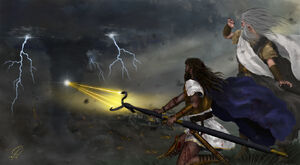
Concept painting showing advance riders of the Great Ordeal, behind sorcerers scourging the edges of the Sranc Horde retreating before them, on their march to Golgotterath.

At the urging of Seswatha, founder of the School of Mandate, Anaxophus V, High King of Kyraneas, wields the Heron Spear against the No-God at Mengedda, thus ending the First Apocalypse.
The Apocalypse was a protracted series of wars and atrocities that obliterated the Ancient North.
Causes[]
The roots of the Apocalypse are many and deep. Mandate scholars (who, popular opinion to the contrary, are not recognized authorities on the subject) argue that they are older than recorded history. More sober accounts reach back no further than the so-called Nonman Tutelage, which eventually led the Gnostic School of Mangaecca to the site of the Incû-Holoinas, the Ark-of-the-Skies, where it lay protected, hidden by Nonmen glamors in the shadow of the western Yimaleti Mountains. Accounts are incomplete, but it seems clear that what were called the Great Sranc Wars were a consequence of the Mangaecca occuption of what would come to be called Golgotterath.
Traditionally, scholars date the beginning of the Apocalypse with Anasûrimbor Celmomas II's call for a holy war against Golgotterath, his Great Ordeal, which is to say, with the beginning of the accounts found in The Sagas, the primary historical source text for this cataclysmic event. Legend has it that the Nonmen Siqû informed the Grandmaster of the Sohonc (the pre-eminent Sauglish School) that the Mangaecca, or Consult as they had come to be called, had uncovered lost Inchoroi secrets that would lead to the world's destruction. Seswatha in turn convinced Celmomas to declare war on Golgotterath in 2123.
The Great Ordeal[]
There has been much debate regarding the next twenty years, and much severe criticism of the pride and bickering that would eventually destroy the Ordeal. What most fail to realize is that the threat facing the High Norsirai of Kûniüri and Aörsi at this time was entirely hypothetical. In fact, it is surprising that Celmomas was able to hold his coalition, which included Nonmen as well as token contingents of Kyraneans, together for as long as he did.
The first great battle, fought in 2124 on the fields of Agongorea, was indecisive. Celmomas and his allies wintered in Dagliash and forded the River Sursa the following spring, catching their foe unawares. The Consult withdrew to Golgotterath, and so began what would be called the Great Investiture. For six years the Ordeal attempted to starve the Consult into submission, to no avail. Every assault proved disastrous. Then, in 2131, after a dispute with King Anasûrimbor Nimeric of Aörsi, Celmomas himself abandoned his own Holy War. The following year disaster struck. Consult legions, apparently using a vast subterranean network of tunnels, appeared in the Ring Mountains to the rear of the Ordeal. The coalition host was all but destroyed. Embittered by the loss of his sons, Nil'giccas, the Nonman King of Ishterebinth, withdrew altogether, leaving the Aörsi to war alone.
The Fall Of Aörsi[]
The following years witnessed a string of further disasters. In 2133 the Aörsi were defeated at the Passes of Amnerlot, and Daliash was lost soon after. King Nimeric withdrew to his capital of Shiarau. A year passed before Celmomas acknowledged his folly and mobilized to relieve him. By then it was too late. In 2135, Nimeric was mortally wounded in the Battle of Hamuir, and Shiarau fell to the Consult legions the following spring. The Aörsic house of Anasûrimbor had perished forever.
Now it was Kûniüri that stood alone. His credibility destroyed, Celmomas was unable to rally any allies, and for a time the situation seemed bleak. But in 2137 his youngest son, Anasûrimbor Nau-Cayûti, managed to rout the Consult at the Battle of Ossirish, where he earned the name Murswagga, or "Dragonslayer", for killing Tanhafut the Red. His next victory, within sight of Shiarau's ruins, was more complete still. The Consult's remaining Sranc and Bashrag fled across the River Sursa. In 2139 the young Prince besieged and recaptured Dagliash, then launched several spectacular raids across the Plains of Agongorea.
Raid Of The Incû-Holoinas[]
Then, in 2140, Nau-Cayûti's beloved concubine, Aulisi, was abducted by Sranc marauders and taken to Golgotterath. According to The Sagas, Seswatha was able to convince the Prince (who was once his student) that she could be rescued from the Incû-Holoinas, and the two of them embarked on an expedition that is almost certainly apocryphal. Mandate commentators dispute the account found in The Sagas, where they successfully return with both Aulisi and the Heron Spear, claiming that Aulisi was never found. Whatever happened, at least two things are certain: the Heron Spear was in fact recovered, and Nau-Cayûti died shortly after (apparently poisoned by his first wife, Iëva).
Awakening Of The No-God[]
In 2141, the Consult returned to the offensive, wrongly thinking the Kûniüri crippled by the loss of their greatest and most beloved son. But Nau-Cayûti's mead-brothers proved themselves able, even brilliant, commanders. At the Battle of Skothera, the Sranc hordes were crushed by General En-Kaujalau, though he died of mysterious causes within weeks of this victory (according to The Sagas, he was another victim of Iëva and her poisons, but again this is disputed by Mandate scholars). In 2142, General Sag-Marmau inflicted yet another crushing defeat on Aurang and his Consult legions, and by the fall of that year he had hounded the remnant of their horde to the Gates of Golgotterath itself.
But the Second Great Investiture proved far shorter than the first. As Seswatha had feared, the Consult had been merely playing for time, nothing more. In the spiring of 2143 the No-God, summoned by means unknown, first drew breath. Across the world, Sranc, Bashrag, and Wracu -- all the obscene progeny of the Inchoroi -- hearkened to his call. Sag-Marmau and the greater glory of Kûniüri were annihilated.
The effect of his coming cannot be overestimated. As numerous independent accounts attest, all Men could sense his dread presence on the horizon, and all infants were born dead. Anasûrimbor Celmomas II had little difficulty gathering support for his Second Ordeal. Nil'giccas and Celmomas were reconciled. Across Eärwa, hosts of Men began marching towards Kûniüri.
But it was too late.
The Years Of The Crib[]
Celmomas and his Second Ordeal were destroyed on the Fields of Eleneöt in 2146. The Heron Spear, which could not be used because the No-God refused to give battle, was lost. Kûniüri and all the great and ancient cities of the River Aumris were destroyed the following year. The Nonmen of Injor-Niyas retreated to Ishterebinth. Eämnor was laid waste the year after, though its capital, Atrithau, raised on anarcane ground, managed to survive. The list continues. Akksersia and Harmant in 2149. The Meöri Empire in 2150. Inweära in 2151, though the city of Sakarpus was spared. The Shiradi Empire in 2153.
The Battle of Kathol Pass, fought primarily by the remnants of the Meöri and the Nonmen of Cil-Aujas in the autumn of 2151, would be mankind's only victory during these dark years, one which was entirely undone when the Meöri turned on their benefactors and sacked the ancient Nonman Mansion the following spring (which gave birth to the myth that the Galeoth, the descendants of those Meöri refugees, were forever cursed with treachery and fractiousness).
Though defeated at the Battle of Mehsarunath in 2154, Anaxophus V, the High King of Kyraneas, managed to save the core of his host and fled southward, abandoning Mehtsonc and Sumna to the Scylvendi. The Tusk was evacuated and brought to ancient Invishi in Nilnamesh. Though the historical record is scant, Mandate scholars insist that it was at this time that the High King admitted to Seswatha that his knights had rescued the Heron Spear from the Fields of Eleneöt eight years previously.
The Slaying Of The No-God[]
Perhaps no single event from this dark time has inspired more acrimony and debate among Three Seas scholars of the Apocalypse. Some historians, the great Casidas among them, have called this the most monstrous deception in history. How could Anaxophus conceal the only weapon that could defeat the No-God while the greater part of the world died? But others, including many belonging to the Mandate, argue precisely the opposite. They admit that Anaxophus's motive -- to save Kyraneas and Kyraneas alone -- was more than a little suspect. But they point to the fact that had he not hidden the Heron Spear, it would surely have been lost in the catastrophes following the Fields of Eleneöt and the Second Ordeal. According to extant accounts, not once did the No-God expose himself to battle during this time. It was the years of attrition that forced him to intercede in the Second Battle of Mengedda.
Whatever the case, the No-God, or Tsuramah as the Kyraneans called him, was destroyed by Anaxophus V in 2155. Freed of his terrible will, his Sranc, Bashrag, and Wracu slaves dispersed. The Apocalypse had ended, and Men set out to recover what they could of a ruined world.[1]
Battles[]
- Battle of Hamuir
- Battle of Ossirish
- Battle of Skothera
- Battle of Eleneöt Fields
- Battle of Kathol Pass
- Battle of Mehsarunath
- Second Battle of Mengedda
References[]
- ↑ Encyclopedic Glossary, ‘Apocalypse’
